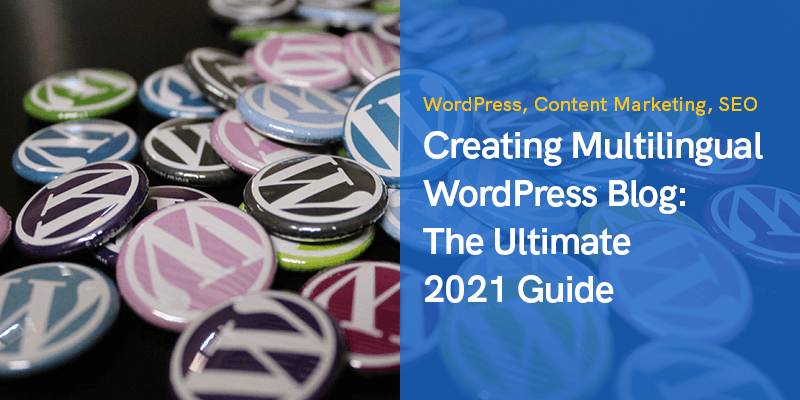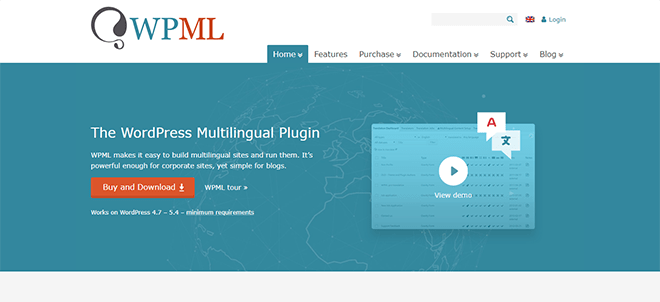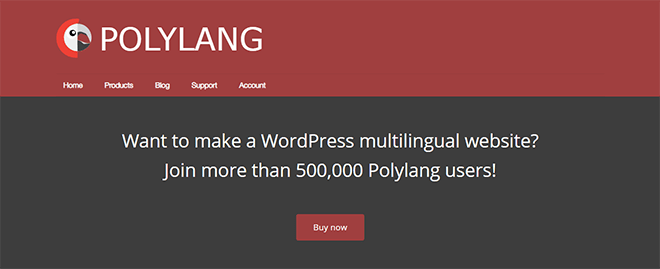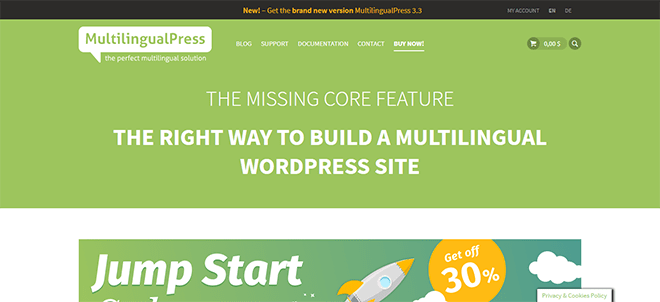
Creating Multilingual WordPress Blog: The Ultimate 2023 Guide
WordPress hosts over 35% of all the blogs and websites on the internet.
A large percentage of them cater to the non-English or multilingual audiences.
This means, if you are still not translating your WordPress blog into multiple languages, you are missing out on a magnificent opportunity to significantly boost your traffic.
That is a rookie mistake to make, especially since creating a multilingual WordPress blog is a fairly easy and straightforward thing to do.
Want to know how to multiply the number of your visitors and rank higher in the search engine results? Read on!
In case you're using Elementor page builder and you're seeking for the best Elementor themes in the market, you can check out our comprehensive article: 10 Best WordPress Elementor Themes
What Is a Multilingual WordPress Blog?
A multilingual WordPress blog is a blog that provides the same content in more than one language.
In order to showcase the correct version of the site, the system either analyses the region of the user visiting automatically, or allows a selection of the preferred language using a dropdown link.
Most often, a multilingual WordPress blog operates using the WordPress Multisite feature.
According to Brian Casel, “WordPress Multisite is a special “mode” built into WordPress, which allows you to create a network of multiple websites, all running on a single installation of WordPress”.
Why Do You Need a Multilingual WordPress Blog?
There are several benefits of translating your WordPress into different languages:
- SEO Advantages: Search engine crawlers will index your translated content as separate content, which can boost your overall rating and bring you up on the search results page.
For instance, there is evidence to suggest that duplicating your blog in 10 different languages can increase your traffic by at least 20%.
Say, if you are looking up csgo bet sites in French, the search engine will return your French version of the blog even if it was originally published in English. - Better user experience: If you understand the needs of your audience and appeal to those, you can expect the number f your loyal readers to increase over time.
- Better trust and credibility.
How to Create a Multilingual WordPress Blog: A Step-by-Step Guide
Here is the step-by-step guide for creating a multilingual WordPress blog:
Identifying the Target Languages
The first thing you need to do before you start working on creating a multilingual WordPress blog is to decide which languages you are going to translate it into.
There are several ways to identify your target languages.
Depending on the primary location of your blog, you might want to consider several approaches to identifying the target languages.
From Within Your Country
If you are setting up a WordPress blog in the country you live in, you should already know which languages dominate it.
It is essential you assess which languages make up a significant part of the population you want to target in your blog and serve them.
For example, if you are running a blog in the US, you might want to double your blog in English into Spanish, too.
There is a lot of Hispanic audience in the United States.
If any of the representatives of this demographic are your target audience, catering to their needs could be a winning decision.
If You Are Looking to Target the Areas Overseas
However, if you are trying to expand your blog and would like to target a country that you have little to no knowledge about, you need to conduct some preliminary research.
There are a couple of ways in which you can do that:
- Use Google Analytics: Google Analytics is a powerful analytical tool that can help you see which language is spoken among the people that comprise your target audience.
- Turn to the help of the natives of the country: Another great idea is questioning the already existing customers/users that could give you an insight into how popular and in demand the topics you cover in your blog are in their local region.
- Scan your blog: You can scan your blog and see what article topics are popular among multilingual visitors.
- Utilize Translation Memory: Leveraging translation memory systems can significantly enhance the translation process for your blog. Translation memories store previously translated segments, which can be reused for future translations, ensuring consistency and reducing translation time and costs.
Translating the Blog
While multilingual WordPress blog creation is not that difficult of a task, you need to settle down the elements that need to be translated before you get down to the actual translation process.
Here’s a checklist of all the things that you need to keep in mind when creating a multilingual WordPress blog:
- Posts
- Metadata
- Attachments and featured images
- Widgets
- Menus
- Theme Options (check out Deep Premium WordPress Theme)
Manual Multilingual Creation (Translation Plugins)
One of the most efficient ways to create a multilingual WordPress blog is by using a translation plugin.
There are different options available on the internet, with you being able to decide on the plugin that will be the most beneficial to you.
There are several parameters that define the plugins such as the number of languages supported, the diversity of the languages supported, the price, etc.
The three most popular plugins for building multilingual WordPress blogs are:
We have wrote a full comprehensive article about ten best WordPress translation and multilingual plugins, make sure to check it out: 10+ Best WordPress Translation Plugins
WPML (WordPress Multilingual)
WPML is one of the most popular plugins for creating multilingual WordPress blogs as it has over 40 different languages built in.
It is very straightforward, so you do not need to spend a lot of time teaching yourself how to navigate it.
Besides, it also allows to add several variations of the same language.
All you need to do in order to translate your WordPress blog into other languages is to open the page you want to translate, get it manually translated by a dedicated person or AI, and then mark it ‘completed’.
Once you do that, you can add ‘language switchers’ on your blog’s page so that the visitors would be redirected to the correct page once they reach your blog and select the language they want to see your content in.
One of the best things about WPML is the fact that you can link your WordPress plugin to the translator you are utilizing, and get it translated automatically without you running it through yourself.
The only downside of this plugin in the fact that it is not free to use.
If you want to get the most out of your time using it, you will be looking at the price of a $29 initial payment and a $21 annual installment after that.
Polylang
If you don’t want to break your budget trying to build a multilingual WordPress blog, you can always rely on Polylang.
One of the best things about this plugin is that the basic version of it is free.
Although the premium version provides more flexibility, for example optimizing all the versions of your blog to have the same URLs, the free version is still pretty extensive and offers decent functionality.
It is similar to the previous plugin in terms of giving you an opportunity to manually translate all the pages of your blog into as many languages as you want.
All you need to do in order to arrange that is to select the language you want to incorporate into your WordPress blog, translate the content and save it so that Polylang could automatically integrate it into the interface of your blog.
MultilingualPress
MultilingualPress is quite different to the two previous options as it allows you to operate each language version of your blog as a separate site.
This means that you are not limited to a set number of languages as you can create as many versions of your blog as you wish.
It is very convenient to use this plugin as all the versions are independent.
This means if you decide to terminate the plugin, all of the current versions will still be fully operational.
Automatic Multilingual Creation
Plugins allow you to translate your blog manually.
Manual work is always a high quality work.
However, you should not feel pressured into doing all the work yourself.
Artificial Intelligence is developing at an astonishing rate, which means more and more bloggers can rely on the automatic services to ensure their platforms are multilingual.
All you need to do to create an automatic multilingual WordPress blog is find the appropriate tool to automate the process.
Some of the best tools for bloggers of all calibers are Google Translator and Transposh.
The former one is great for beginners as it is one of the most straightforward automatic plugins on WordPress.
Besides, it also has a lot of languages available, too!
The latter one, on the other hand, is better for more advanced blogs as it allows for a full multilingual adaptation of the blog.
Not only can you translate the contents of your blog but also comments and other types of reader feedback.
On top of that, it is perfect for boosting your engagement levels as it provides users with an option of ‘requesting’ translations of certain bits of your blog and making contributions towards it.
The Bottom Line
Creating a multilingual WordPress blog is an easy process once you get all the detail down.
With a large number of different tools and plugins available on the market, you can translate your blog without any hustle at all, and see the first results of this action very soon!
Recommended Posts

Marketing Tactics for WordPress Excellence in 2024
January 22, 2024

12 Reasons to Consider WordPress for Your First Website in 2024
January 17, 2024

Enhancing WordPress Sites with Computer Vision Capabilities
December 27, 2023


